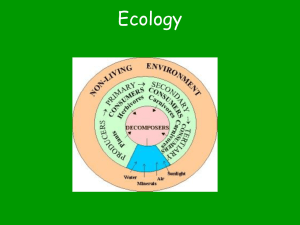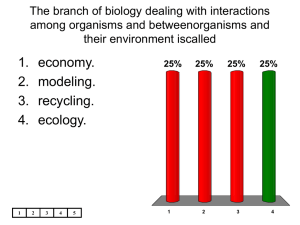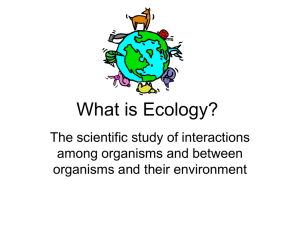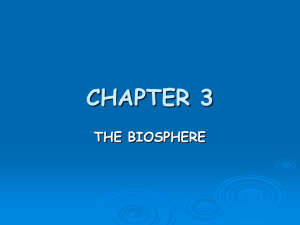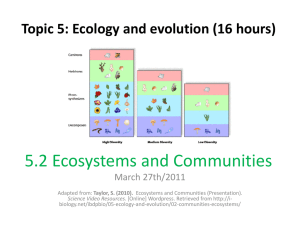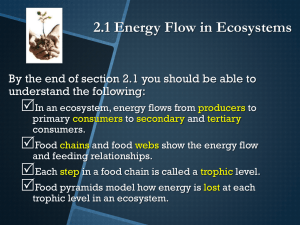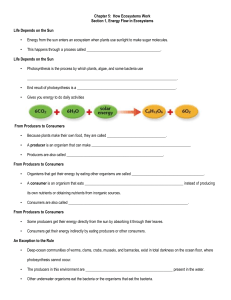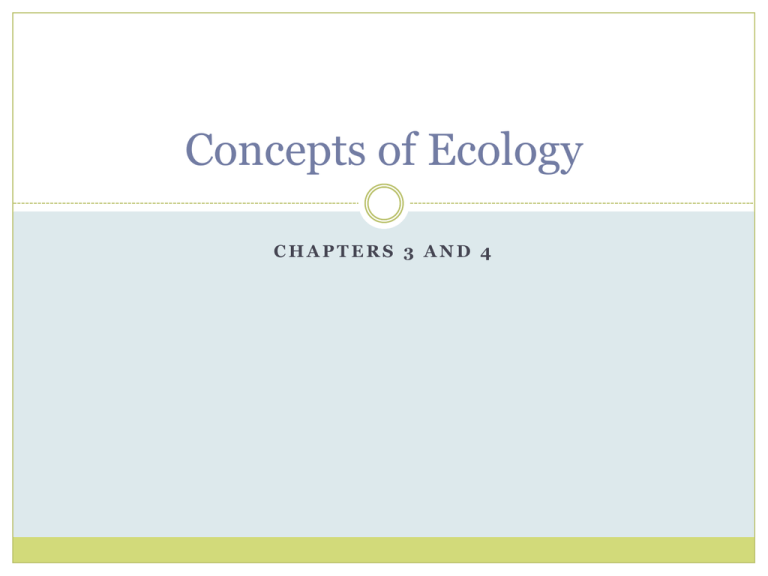
Concepts of Ecology
CHAPTERS 3 AND 4
3–1 What Is Ecology?
Objectives:
Describe the study of Ecology
Explain how biotic and abiotic factors influence an
ecosystem
Describe the methods used to study ecology
What is ecology?
Ecology is the scientific study of interactions
among organisms and between organisms and
their physical environment
Interactions and Interdependence
Interactions within the
biosphere produce a web of
interdependence between
organisms and the
environment in which they
live.
The interdependence of
life on Earth contributes to
an ever-changing, or
dynamic, biosphere.
Biosphere
The biosphere contains the combined portions of
the planet in which all of life exists, including:
• land
• water
• air, or atmosphere
The biosphere extends from about 8 kilometers
above Earth's surface to as far as 11 kilometers
below the surface of the ocean.
Levels of Organization
To understand relationships within the biosphere,
ecologists may study these ecological levels of
organization:
Organism
Population
Community
Ecosystem
Biome
Biosphere
Organism: Individual member of a
species- group of organisms that are
physically similar and can interbreed with
one another to produce fertile offspring
Bison
Copyright Pearson Prentice Hall
Population
Group of organisms of the same species
living in the same area
Bison herd
Copyright Pearson Prentice Hall
Community
All populations that live together in a
defined area
Hawk, snake, bison, prairie dog, grass
Copyright Pearson Prentice Hall
Ecosystem
All the populations and the physical surroundings
Hawk, snake, bison, prairie dog, grass, stream, rocks, air
Copyright Pearson Prentice Hall
Ecosystem includes the biotic (living) and abiotic
(nonliving) factors
Biome
Group of similar ecosystems that share similar climates
and dominant communities of organisms (e.g tall
grasses)
Prairie biome
Copyright Pearson Prentice Hall
Biosphere
The part of Earth that contains all
ecosystems
Copyright Pearson Prentice Hall
Ecological Levels of Organization
Methods Ecologists Use
All of these approaches rely on the application of scientific methods to
guide ecological inquiry
Ecological Models
Modeling- used to explain large-scale phenomena
too large or too complex to study with observation or
experiments alone
Examples:
Food webs
Biogeochemical cycle diagrams
Carbon cycle affects all levels of ecological organization up to
the biosphere. A model helps make all aspects of the
phenomenon observable
3-2 Energy, Producers, and Consumers
Objectives:
Define primary producers
Describe how consumers obtain energy and nutrients
Role of Primary Producers
Energy is required for all life processes
Energy flows from the sun or inorganic compounds to
autotrophs (producers).
Heterotrophs (consumers) eat producers to get energy.
Without a constant input of energy, living systems
cannot function.
The primary source of energy on Earth is the sun
Role of Primary Producers
Autotrophs – “self feeder”
Most use sunlight to create carbohydrates via
photosynthesis
Oxygen created as a byproduct
Ex: Plants, some protists (algae) and some bacteria
Some bacteria create organic compounds from
inorganic chemicals in a process called
chemosynthesis
Live in remote places.
Also can make carbohydrates and oxygen
Energy Flow: Role of Producers
Role of Primary Producers
Autotrophs (plants, some bacteria) are called
primary producers
the first producers of energy-rich compounds that
are later used by other organisms
some of their self-made energy is stored and available to
other organisms that eat them
Mmm…this
plant is
delicious.
Role of Consumers
Heterotroph –
“different feeder”
Cannot harness energy
directly from the
physical environment.
Must ingest food to
obtain energy
Ex: animals, fungi,
some bacteria, some
protists
Energy Flow: Role of Consumers
There are many different types of heterotrophs.
Herbivores eat plants.
Carnivores eat animals.
Omnivores eat both plants and animals.
Detritivores feed on plant and animal remains and
other dead matter.
Decomposers, like bacteria and fungi, break down
organic matter.
Scavengers consume carcasses of animals that have
been killed by other predators
Ch 3-3 Energy Flow in Ecosystems
Objectives:
Trace the flow of energy through living ecosystems
Identify 3 types of ecological pyramids
Food Chains
Energy flows through an ecosystem in one direction
from producers to consumers
A food chain is a series of steps in which organisms
transfer energy by eating and being eaten
a single path of energy transfer in an ecosystem
from the sun or inorganic compounds (not usually pictured)
autotrophs (producers) various heterotrophs (consumers).
Phytoplankton,
floating algae, are
primary producers
in aquatic food
chains
Energy Flow: Food Webs
A food web is the complex network of feeding
relationships in an ecosystem
links all the food chains in an ecosystem together
Can provide information to determine the type of
heterotroph
Trophic
levels
Energy Flow: Trophic Levels
Each step in a food chain
or food web is called a
trophic level.
•
Producers make up
the first trophic level.
•
Consumers make up
the second, third, or
higher trophic levels.
•
Each consumer
depends on the
trophic level below it
for energy.
•
A single organism
may occupy more
than one trophic
level
Energy Flow: Role of Decomposers
Ecological Pyramids
An ecological pyramid is a diagram that shows the relative amounts
of energy or matter contained within each trophic level in a food chain
or food web.
Ecological Pyramids: Energy Pyramids
Only about 10
percent of the
energy available
within one
trophic level is
transferred to
organisms at the
next trophic
level.
Ecological Pyramids: Energy Pyramids
Organisms use some of
the energy for their own
life processes
Most is lost to the
environment as heat
Ch 3-4 Cycles of Matter
Objectives:
Describe how matter cycles among the living and
nonliving parts of an ecosystem
Describe how water cycles through the biosphere
Explain why nutrients are important to living things
Describe how the availability of nutrients affects the
productivity of ecosystems
3-3 Cycling Matter
Recycling in the
Biosphere
Matter is recycled
within and between
ecosystems.
Matter moves through
an ecosystem in
biogeochemical
cycles
Biogeochemical Cycles
4 cycles of interest:
water
carbon
nitrogen
phosphorus
Nutrients are all the chemical substances that an
organism needs to sustain life.
required to build tissues and carry out essential life functions
Circulated throughout biosphere in biogeochemical
cycles
Water Cycle
All living
things need
water
Water Cycle
Biotic parts of the ecosystem gain water by
Drinking
Absorption
And lose it back to the environment through
Transpiration (plants)
Urination and exhalation of water vapor (animals)
Carbon Cycle
Nitrogen Cycle
Nitrogen Cycle
Nitrogen
is needed for protein and nucleic acid
synthesis
78% of Earth’s atmosphere is nitrogen gas (N2)
Nitrogen containing products that can be used
by plants
Ammonia (NH4)
Nitrate ions (NO3-)
Heterotrophs can only get nitrogen by eating
other organisms
Bacteria and the Nitrogen Cycle
Converting nitrogen gas into
ammonia is called nitrogen fixation
Only certain species of bacteria can
do this
Found living on plant roots or in soil
Other nitrifying bacteria convert
ammonia into nitrates
A process called ammonification
Plants use the converted products
(NH4 and NO3-) to make plant
proteins
A process called assimilation
Some bacteria convert nitrates into
nitrogen gas (denitrification).
Like in phosphorus and carbon
cycles, bacteria act as decomposers
returning nitrogen back to soil
Root nodules on a legume
Phosphorus Cycle
Phosphorus Cycle
Phosphorus
is important for the formation of DNA
and RNA molecules.
Plants assimilate phosphorus that is in the soil
Animals get phosphorus by eating other
organisms
Phosphorus is not very common and does not enter
the atmosphere, instead it is found mostly on land
in rock and soil.
Carbon Cycle
Required for photosynthesis
Released during the process of cellular respiration
Nutrients and Productivity
o The primary productivity of an ecosystem is
the rate at which organic matter (biomass) is
created by producers.
o One factor that controls the primary
productivity of an ecosystem is the amount of
available nutrients
Nutrients and Productivity
When a limiting nutrient, phosphorus, nitrogen, etc.,
is introduced it can cause bursts productivity
Ex: algal blooms
Compared to land, open oceans are nutrient poor
Energy and Matter in Ecosystems:
The Main Idea
Energy flows in
one direction
Matter is
transferred and
recycled between
the biotic and
abiotic parts of
ecosystems
Niche
An organism’s niche includes how it survives
and reproduces in its environment. This
includes:
Place in food web
Environmental conditions it needs to survive
Type of food it eats
How it obtains food
Other species that use it as food
When and how it reproduces
What is the niche of a bullfrog?
Niche
Competitive Exclusion Principle - no two species can
occupy the same niche in the same habitat at the
same time
Sharing a niche results in competition in nature often results in
winner and loser – losing organism fails to survive
Different species can occupy similar niches.
Resource partitioning helps organisms with similar niches
avoid competition
Warbler Niches
Cape May Warbler
Feeds at the tips of branches
near the top of the tree
Bay-Breasted Warbler
Feeds in the middle
part of the tree
Spruce tree
Yellow-Rumped Warbler
Feeds at the lower parts of
the tree and bases of middle
branches
Community Interactions
Competition- same or different species
attempt to use an ecological resource in the
same place at the same time
Community Interactions
Predation - one organism captures
and feeds on another organism
Predator – the one killing and eating
Prey – the food
Community Interactions-Symbiosis
Symbiosis- an interaction between two species living
close together
Three types:
Parasitism – one is harmed (host), one benefits (parasite)
Mutualism – both benefit
Commensalism – one is neutral, one benefits
Mutualism
Parasitism
Commensalism

